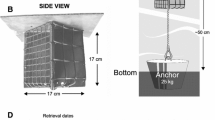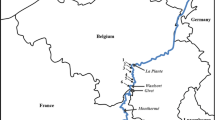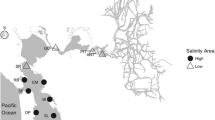Abstract
Interactions between anthropogenic disturbances and introduced and native species can shift ecological communities, potentially leading to the successful establishment of additional invaders. Since its discovery in New Jersey in 1988, the Asian shore crab (Hemigrapsus sanguineus) has continued to expand its range, invading estuarine and coastal habitats in eastern North America. In estuarine environments, H. sanguineus occupies similar habitats to native, panopeid mud crabs. These crabs, and a variety of fouling organisms (both NIS and native), often inhabit man-made substrates (like piers and riprap) and anthropogenic debris. In a series of in situ experiments at a closed dock in southwestern Long Island (New York, USA), we documented the impacts of these native and introduced crabs on hard-substrate fouling communities. We found that while the presence of native mud crabs did not significantly influence the succession of fouling communities compared to caged and uncaged controls, the presence of introduced H. sanguineus reduced the biomass of native tunicates (particularly Molgula manhattensis), relative to caged controls. Moreover, the presence of H. sanguineus favored fouling communities dominated by introduced tunicates (especially Botrylloides violaceous and Diplosoma listerianum). Altogether, our results suggest that H. sanguineus could help facilitate introduced fouling tunicates in the region, particularly in locations where additional solid substrates have created novel habitats.



Similar content being viewed by others
References
Bullard SG, Whitlatch RB, Osman RW (2004) Checking the landing zone: Do invertebrate larvae avoid settling near superior spatial competitors? Mar Ecol Prog Ser 280:239–247
Canning-Clode J, Fofonoff P, McCann L et al (2013) Marine invasions on a subtropical island: Fouling studies and new records in a recent marina on Madeira island (Eastern Atlantic Ocean). Aquat Invasions 8:261–270
Clarke Murray C, Therriault TW, Martone PT (2012) Adapted for invasion? Comparing attachment, drag and dislodgment of native and nonindigenous hull fouling species. Biol Invasions 14:1651–1663
Collin SB, Johnson LE (2014) Invasive species contribute to biotic resistance: negative effect of caprellid amphipods on an invasive tunicate. Biol Invasions 16:1–11
Dijkstra J, Harris LG, Westerman E (2007) Distribution and long-term temporal patterns of four invasive colonial ascidians in the Gulf of Maine. J Exp Mar Biol Ecol 342:61–68
Dijkstra JA, Westerman EL, Harris LG (2011) The effects of climate change on species composition, succession and phenology: a case study. Glob Change Biol 17:2360–2369
Dumont CP, Gaymer CF, Thiel M (2011) Predation contributes to invasion resistance of benthic communities against the non-indigenous tunicate Ciona intestinalis. Biol Invasions 13:2023–2034
Epifanio CE (2013) Invasion biology of the Asian shore crab Hemigrapsus sanguineus: a review. J Exp Mar Biol Ecol 441:33–49
Fehlauer-Ale KH, Winston JE, Tilbrook KJ et al (2015) Identifying monophyletic groups within Bugula sensu lato (Bryozoa, Buguloidea). Zool Scr 44:334–347
Fofonoff P, Ruiz G, Steves B, et al (2003) National Exotic Marine and Estuarine Species Information System. http://invasions.si.edu/nemesis/. Accessed on 30 Oct 2015
Freestone AL, Ruiz GM, Torchin ME (2013) Stronger biotic resistance in tropics relative to temperate zone: effects of predation on marine invasion dynamics. Ecology 94:1370–1377
Glasby TM, Connell SD, Holloway MG et al (2007) Nonindigenous biota on artificial structures: could habitat creation facilitate biological invasions? Mar Biol 151:887–895
Griffen BD, Altman I, Hurley J et al (2011) Reduced fecundity by one invader in the presence of another: a potential mechanism leading to species replacement. J Exp Mar Biol Ecol 406:6–13
Griffen BD, Altman I, Bess BM et al (2012) The role of foraging in the success of invasive Asian shore crabs in New England. Biol Invasions 14:2545–2558
Griffen BD, Delaney DG (2007) Species invasion shifts the importance of predator dependence. Ecology 88:3012–3021
Griffen BD, Guy T, Buck JC (2008) Inhibition between invasives: a newly introduced predator moderates the impacts of a previously established invasive predator. J Anim Ecol 77:32–40
Grosberg RK (1981) Competitive ability influences habitat choice in marineinvertebrates. Nature 290:700–702
Johnson LE, Strathmann RR (1989) Settling barnacle larvae avoid substrata previously occupied by a mobile predator. J Exp Mar Biol Ecol 128:87–103
Kimbro DL, Cheng BS, Grosholz ED (2013) Biotic resistance in marine environments. Ecol Lett 16:821–833
Lambert CC, Lambert G (2003) Persistence and differential distribution of nonindigenous ascidians in harbors of the Southern California Bight. Mar Ecol Prog Ser 259:145–161
Lohrer AM, Whitlatch RB (2002) Relative impacts of two exotic bracyuran species on blue mussel populations in Long Island Sound. Mar Ecol Prog Ser 227:135–144
Matassa CM, Trussell GC (2011) Landscape of fear influences the relative importance of consumptive and nonconsumptive predator effects. Ecology 92:2258–2266
McDermott JJ (1991) A breeding population of the Western Pacific Crab Hemigrapsus sanguineus crustacea decapoda grapsidae established on the Atlantic Coast of North America. Biol Bull 181:195–198
Osman RW, Whitlach RB (1995) Predation on early ontogenetic life stages and its effect on recruitment into a marine epifaunal community. Mar Ecol Prog Ser 117:111–126
Osman RW, Whitlatch RB (2004) The control of the development of a marine benthic community by predation on recruits. J Exp Mar Biol Ecol 311:117–145
Peterson CH (1979) The importance of predation and competition in organizing the intertidal epifaunal communities of Barnegat Inlet, New Jersey. Oecologia 39:1–24
Pollock L (1998) A practical guide to the marine animals of Northeastern North America. Rutgers University Press, New Brunswick
Ricciardi A, Whoriskey FG (2004) Exotic species replacement: shifting dominance of dreissenid mussels in the Soulanges Canal, upper St. Lawrence River,Canada. J North Am Benthol Soc 23:507–514
Ruiz GM, Fofonoff PW, Carlton JT et al (2000) Invasion of coastal marine communities in North America: apparent patterns, processes, and biases. Ann Rev Ecol Syst 31:481–531
Ryland JS, Holt R, Loxton J (2014) First occurrence of the non-native bryozoan Schizoporella japonica Ortmann (1890) in Western Europe. Zootaxa 3780:481–502
Simberloff D (2006) Invasional meltdown 6 years later: Important phenomenon, unfortunate metaphor, or both? Ecol Lett 9:912–919
Simberloff D, Von Holle B (1999) Positive interactions of nonindigenous species: invasion meltdown? Biol Invasions 1:21–32
Simkanin C, Davidson IC, Dower JF et al (2012) Anthropogenic structures and the infiltration of natural benthos by invasive ascidians. Mar Ecol 33:499–511
Tyrrell MC, Byers JE (2007) Do artificial substrates favor nonindigenous fouling species over native species? J Exp Mar Biol Ecol 342:54–60
Wasson K, Fenn K, Pearse JS (2005) Habitat differences in marine invasions of central California. Biol Invasions 7:935–948
Williams SL, Davidson IC, Pasari JR et al (2013) Managing multiple vectors for marine invasions in an increasingly connected world. Bioscience 63:952–966
Winston JE, Hayward PJ (2012) The marine bryozoans of the northeast coast of the United States: maine to virginia. Virginia Museum Nat Hist Memoir 11:1–180
Wonham MJ, O’Connor MI, Harley CDG (2005) Positive effects of a dominant invader on introduced and native mudflat species. Mar Ecol Prog Ser 289:109–116
Yund PO, Collins C, Johnson SL (2015) Evidence of a native Northwest Atlantic COI haplotype clade in the cryptogenic colonial ascidian Botryllus schlosseri. Biol Bull 228:201–216
Acknowledgments
For assistance with field work we would like to thank: Westley Blakeslee, Melanie Bram, James Brown, Steve Harstein, Zack Holmes, Isabela Kernin, Sara Kulins, Jaclyn Onufrey, and the Town of Hempstead Marina and Bay Constables. Comments from James T. Carlton and two anonymous reviewers improved this manuscript.
Author information
Authors and Affiliations
Corresponding author
Rights and permissions
About this article
Cite this article
Freeman, A.S., Frischeisen, A. & Blakeslee, A.M. Estuarine fouling communities are dominated by nonindigenous species in the presence of an invasive crab. Biol Invasions 18, 1653–1665 (2016). https://doi.org/10.1007/s10530-016-1108-3
Received:
Accepted:
Published:
Issue Date:
DOI: https://doi.org/10.1007/s10530-016-1108-3




